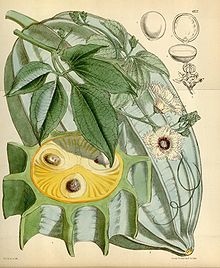Telfairia
| Telfairia | |
|---|---|

| |
| T. occidentalis | |
| Scientific classification | |
| Kingdom: | Plantae |
| Clade: | Tracheophytes |
| Clade: | Angiosperms |
| Clade: | Eudicots |
| Clade: | Rosids |
| Order: | Cucurbitales |
| Family: | Cucurbitaceae |
| Subfamily: | Cucurbitoideae |
| Tribe: | Joliffieae |
| Genus: | Telfairia Hook. |
| Type species | |
| Telfairia pedata (Sm.) Hook.
| |
| Species | |
|
3 - See text. | |
Telfairia is a small genus of flowering plants in the
These vines grow quickly to lengths of 30 meters or more, using tendrils to scale trees. T. pedata is grown as an ornamental plant for its attractive foliage. The seeds of T. occidentalis and T. pedata are over 25% protein and 55% oil, making them a good source of nutrition. They are used as a traditional food source for nursing mothers; the seed flour is fermented to make baby food; and the leaves and shoots, especially of T. occidentalis, are eaten as vegetables.[1]
One recent concern has been the impact of telfairia mosaic virus, which, along with other problems, is a threat to the already low genetic diversity of plants of this genus.
Species:
- Telfairia batesii
- Telfairia occidentalis - fluted pumpkin, oyster nut
- Telfairia pedata (syn. T. africana, Fevillea pedata, Joliffia africana) - oyster nut, queen's nut, Zanzibar oil vine
The genus was named for Irish naturalist Charles Telfair (1778–1833).
References
- ^ Ajayi, S. A., et al. Conservation status of Telfairia spp. in sub-Saharan Africa[permanent dead link]. bioversityinternational.org
